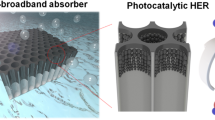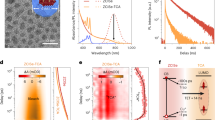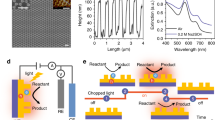Abstract
Solar radiation is the most abundant renewable energy source, however, its overall utilization remains inefficient as half of the energy is in the form of infrared (IR) light, which cannot be harnessed due to its low energy. Upconversion (UC) is an effective means of converting IR radiation to high-energy light. Here, we show a plasmonic CuS/CdS heterostructured semiconductor that can generate energy comparable to that of visible light from IR radiation, with a high efficiency of up to 5.1%. The unique charge dynamics of this system lead to efficient carrier transfer and long-lived charge separation. As a result, photocatalytic coupled redox reactions occur, including oxidation of methanol to formaldehyde and hydrogen evolution, with activities maintained over one week. This work demonstrates the promise of plasmonic UC for utilizing sustainable energy from low-flux IR light.
This is a preview of subscription content, access via your institution
Access options
Access Nature and 54 other Nature Portfolio journals
Get Nature+, our best-value online-access subscription
$29.99 / 30 days
cancel any time
Subscribe to this journal
Receive 12 digital issues and online access to articles
$119.00 per year
only $9.92 per issue
Buy this article
- Purchase on Springer Link
- Instant access to full article PDF
Prices may be subject to local taxes which are calculated during checkout




Similar content being viewed by others
Data availability
The datasets within the article and Supplementary Information are available from the authors upon reasonable request.
Change history
28 October 2022
In the version of this article initially published online, the Supplementary Information file was incorrect and has now been replaced in the HTML version of the article.
04 November 2022
A Correction to this paper has been published: https://doi.org/10.1038/s41893-022-01015-2
References
Chen, Y. et al. Selective recovery of precious metals through photocatalysis. Nat. Sustain. 4, 618–626 (2021).
Fan, Y. et al. Selective photocatalytic oxidation of methane by quantum-sized bismuth vanadate. Nat. Sustain. 4, 509–515 (2021).
Lian, Z. et al. Near infrared light induced plasmonic hot hole transfer at a nano-heterointerface. Nat. Commun. 9, 2314 (2018).
Lian, Z. et al. Plasmonic p–n junction for infrared light to chemical energy conversion. J. Am. Chem. Soc. 141, 2446–2450 (2019).
Yang, W., Liu, Y., Cullen, D. A., McBride, J. R. & Lian, T. Harvesting sub-bandgap IR photons by photothermionic hot electron transfer in a plasmonic p–n junction. Nano Lett. 21, 4036–4043 (2021).
Tagliabue, G. et al. Ultrafast hot-hole injection modifies hot-electron dynamics in Au/p-GaN heterostructures. Nat. Mater. 19, 1312–1318 (2020).
Medishetty, R., Zareba, J. K., Mayer, D., Samoc, M. & Fischer, R. A. Nonlinear optical properties, upconversion and lasing in metal–organic frameworks. Chem. Soc. Rev. 46, 4976–5004 (2017).
Haase, M. & Schafer, H. Upconverting nanoparticles. Angew. Chem. Int. Ed. Engl. 50, 5808–5829 (2011).
Khnayzer, R. S. et al. Upconversion-powered photoelectrochemistry. Chem. Commun. 48, 209–211 (2012).
Yanai, N. & Kimizuka, N. New triplet sensitization routes for photon upconversion: thermally activated delayed fluorescence molecules, inorganic nanocrystals, and singlet-to-triplet absorption. Acc. Chem. Res. 50, 2487–2495 (2017).
Zhao, T., Han, J., Duan, P. & Liu, M. New perspectives to trigger and modulate circularly polarized luminescence of complex and aggregated systems: energy transfer, photon upconversion, charge transfer, and organic radical. Acc. Chem. Res. 53, 1279–1292 (2020).
Seo, S. E. et al. Recent advances in materials for and applications of triplet–triplet annihilation-based upconversion. J. Mater. Chem. C 10, 4483–4496 (2022).
Jha, K. K. et al. Triplet–triplet annihilation upconversion by polymeric sensitizers. J. Phys. Chem. C 126, 4057–4066 (2022).
Naik, G. V. & Dionne, J. A. Photon upconversion with hot carriers in plasmonic systems. Appl. Phys. Lett. 107, 133902 (2015).
Lee, S. H., Nishi, H. & Tatsuma, T. Plasmon-induced charge separation based on a nanocomposite containing MoO2 under visible light irradiation. J. Mater. Chem. C 9, 6395–6398 (2021).
Naik, G. V., Welch, A. J., Briggs, J. A., Solomon, M. L. & Dionne, J. A. Hot-carrier-mediated photon upconversion in metal-decorated quantum wells. Nano Lett. 17, 4583–4587 (2017).
Mubeen, S. et al. An autonomous photosynthetic device in which all charge carriers derive from surface plasmons. Nat. Nanotechnol. 8, 247–251 (2013).
Sundararaman, R., Narang, P., Jermyn, A. S., Goddard, W. A. III & Atwater, H. A. Theoretical predictions for hot-carrier generation from surface plasmon decay. Nat. Commun. 5, 5788 (2014).
Quinn, J. J. & Ferrell, R. A. Electron self-energy approach to correlation in a degenerate electron gas. Phys. Rev. 112, 812–827 (1958).
Echenique, P. M., Pitarke, J. M., Chulkov, E. V. & Rubio, A. Theory of inelastic lifetimes of low-energy electrons in metals. Chem. Phys. 251, 1–35 (2000).
Cui, J. et al. Near-infrared plasmonic-enhanced solar energy harvest for highly efficient photocatalytic reactions. Nano Lett. 15, 6295–6301 (2015).
Wu, K., Chen, J., McBride, J. R. & Lian, T. Efficient hot-electron transfer by a plasmon-induced interfacial charge-transfer transition. Science 349, 632–635 (2015).
Xu, Y. & Schoonen, M. A. A. The absolute energy positions of conduction and valence bands of selected semiconducting minerals. Am. Mineral. 85, 543–556 (2000).
Deng, X. et al. One-pot hydrothermal synthesis of CdS decorated CuS microflower-like structures for enhanced photocatalytic properties. Sci. Rep. 7, 3877 (2017).
Besteiro, L. V., Kong, X.-T., Wang, Z., Hartland, G. & Govorov, A. O. Understanding hot-electron generation and plasmon relaxation in metal nanocrystals: quantum and classical mechanisms. ACS Photonics 4, 2759–2781 (2017).
Brongersma, M. L., Halas, N. J. & Nordlander, P. Plasmon-induced hot carrier science and technology. Nat. Nanotechnol. 10, 25–34 (2015).
Ludwig, J. et al. Ultrafast hole trapping and relaxation dynamics in p-type CuS nanodisks. J. Phys. Chem. Lett. 6, 2671–2675 (2015).
Lian, Z. et al. Anomalous photoinduced hole transport in type I core/mesoporous-shell nanocrystals for efficient photocatalytic H2 evolution. ACS Nano 13, 8356–8363 (2019).
Lian, Z. et al. Durian-shaped CdS@ZnSe core@mesoporous-shell nanoparticles for enhanced and sustainable photocatalytic hydrogen evolution. J. Phys. Chem. Lett. 9, 2212–2217 (2018).
Klimov, V. I., McBranch, D. W., Leatherdale, C. A. & Bawendi, M. G. Electron and hole relaxation pathways in semiconductor quantum dots. Phys. Rev. B 60, 13740–13749 (1999).
Wu, K., Du, Y., Tang, H., Chen, Z. & Lian, T. Efficient extraction of trapped holes from colloidal CdS nanorods. J. Am. Chem. Soc. 137, 10224–10230 (2015).
Carlson, S. A. & Hercules, D. M. Studies on some intermediates and products of the photoreduction of 9,10-anthraquinone. Photochem. Photobiol. 17, 123–131 (1973).
Zhu, H. et al. Auger-assisted electron transfer from photoexcited semiconductor quantum dots. Nano Lett. 14, 1263–1269 (2014).
Tagliabue, G., DuChene, J. S., Habib, A., Sundararaman, R. & Atwater, H. A. Hot-hole versus hot-electron transport at Cu/GaN heterojunction interfaces. ACS Nano 14, 5788–5797 (2020).
Xie, S. et al. Visible light-driven C-H activation and C-C coupling of methanol into ethylene glycol. Nat. Commun. 9, 1181 (2018).
Atamna, H. et al. Methylene blue delays cellular senescence and enhances key mitochondrial biochemical pathways. FASEB J. 22, 703–712 (2008).
Momma, K. & Izumi, F. VESTA 3 for three-dimensional visualization of crystal, volumetric and morphology data. J. Appl. Crystallogr. 44, 1272–1276 (2011).
Yamakata, A. et al. Behavior and energy states of photogenerated charge carriers on Pt- or CoOx-loaded LaTiO2N photocatalysts: time-resolved visible to mid-infrared absorption study. J. Phys. Chem. C 118, 23897–23906 (2014).
Usui, R. et al. Photochromic radical complexes that show heterolytic bond dissociation. J. Am. Chem. Soc. 142, 10132–10142 (2020).
Acknowledgements
This work was supported by a JST JP21H04638 (Grant-in-Aid for Scientific Research [A]) (M.S., K.T. and K.Kobayashi.) and sponsored by the National Nature Science Foundation of China (22109097), the Natural Science Foundation of Shanghai (20ZR1472000) and the Shanghai Pujiang Program (20PJ1411800). This work was also supported by the JST FOREST Program (grant no. PMJFR201M) (M.S.). This work was also supported in part by the NIMS microstructural characterization platform through the Nanotechnology Platform program of the Ministry of Education, Culture, Sports, Science and Technology (MEXT), Japan (JPMXP09A17NM0075). We thank N. Tamai for assisting with the femtosecond TAS measurements.
Author information
Authors and Affiliations
Contributions
Z.L. conceived, designed and carried out the materials fabrication and catalytic reaction experiments. M.S. conceived and designed the experiments. T.T. provided intellectual and technical guidance. J.M.M.V., C.S.K.R., A.Y. and Y.K. carried out the TA experiments. K.Kobayashi and K.T. designed and provided technical guidance for the alcohol oxidation reaction. T.N. and K.Kimoto carried out the high-resolution TEM and elemental mapping. Z.L. and M.S. wrote the manuscript. All authors participated in the discussion of the research.
Corresponding authors
Ethics declarations
Competing interests
The authors declare no competing interests.
Peer review
Peer review information
Nature Sustainability thanks Mengtao Sun, Reuven Gordon and the other, anonymous, reviewer(s) for their contribution to the peer review of this work.
Additional information
Publisher’s note Springer Nature remains neutral with regard to jurisdictional claims in published maps and institutional affiliations.
Supplementary information
Supplementary Information
Supplementary Notes 1–5, Figs. 1–33 and Tables 1–3.
Rights and permissions
Springer Nature or its licensor (e.g. a society or other partner) holds exclusive rights to this article under a publishing agreement with the author(s) or other rightsholder(s); author self-archiving of the accepted manuscript version of this article is solely governed by the terms of such publishing agreement and applicable law.
About this article
Cite this article
Lian, Z., Kobayashi, Y., Vequizo, J.J.M. et al. Harnessing infrared solar energy with plasmonic energy upconversion. Nat Sustain 5, 1092–1099 (2022). https://doi.org/10.1038/s41893-022-00975-9
Received:
Accepted:
Published:
Issue Date:
DOI: https://doi.org/10.1038/s41893-022-00975-9



